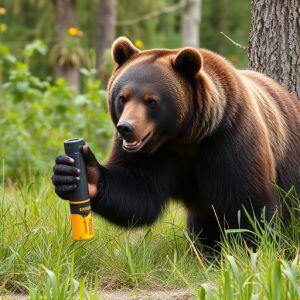Bear Spray Defense: Navigating Airport Travel Regulations for Safe Encounters
Bear spray, a capsaicin-based repellent, is vital for safety in regions with bear populations, deter…….
Bear spray, a capsaicin-based repellent, is vital for safety in regions with bear populations, deterring attacks through pain. Airport travel regulations increasingly mandate guidelines on carrying bear spray as a hazardous material, with specific rules varying by airline and destination. Choosing the right bear spray involves considering location, terrain, and intended use, while adhering to airport standards for quantity and packaging. Effective use requires training in application techniques, wind awareness, noise making, and physical resistance, ensuring safety alongside other precautions when navigating predatory territories.
“In regions where wild predators like bears roam, knowing how to protect yourself is vital. This guide explores bear spray—a powerful defense tool against potential threats. We delve into ‘Understanding Bear Spray’ and its effectiveness, especially in predator encounter scenarios. ‘Airport Travel Regulations’ section examines permits and restrictions for carrying bear spray, ensuring safe travel. Additionally, we offer tips on choosing the right spray and critical safety precautions for optimal defense. Be prepared, stay safe.”
- Understanding Bear Spray: What It Is and How It Works
- Airport Travel Regulations: Bear Spray Permits and Restrictions
- Choosing the Right Bear Spray for Your Needs
- Effective Use of Bear Spray in Predator Encounter Situations
- Safety Precautions and Training for Optimal Bear Spray Defense
Understanding Bear Spray: What It Is and How It Works
Bear spray, also known as bear repellent, is a powerful tool designed to protect individuals from potential bear attacks. It’s not just for outdoor enthusiasts; even those traveling through areas with bear populations can benefit from its use. Understanding how bear spray works is essential for safety in regions where bears are prevalent. This defense mechanism utilizes capsaicin, the active ingredient found in chili peppers, to create a painful and unpleasant experience for the bear, encouraging it to retreat.
When used correctly, bear spray forms a protective barrier, creating a temporary yet effective shield between the user and the potential predator. Airport travel regulations often include guidelines on carrying bear spray as part of your luggage, ensuring that visitors are prepared for encounters with bears during outdoor activities or in remote areas. Knowing how to apply it effectively can make all the difference when facing an aggressive bear encounter.
Airport Travel Regulations: Bear Spray Permits and Restrictions
When traveling through airports, especially in regions with known bear populations, understanding bear spray airport travel regulations is paramount. Many airlines and airports have specific rules regarding the transportation of bear spray as a defense mechanism against predators. Typically, bear spray is categorized as a hazardous material due to its potent ingredients, necessitating special handling procedures.
Permits are often required for carrying bear spray on flights, with restrictions varying by airline and destination. These permits typically involve declaring the item upon check-in or during security screening. Some airports may even have designated areas for securely storing bear spray until your flight departs. Compliance with these regulations ensures a safe journey for all passengers while facilitating smooth airport navigation.
Choosing the Right Bear Spray for Your Needs
When considering bear spray as a defensive measure against predators, it’s crucial to select the right product tailored to your specific needs and environment. Factors like bear species prevalent in your area, typical terrain you’ll be traversing, and intended use (e.g., hiking, camping, airport travel) play a significant role in making an informed choice. Bear spray is subject to airport travel regulations, so understanding the allowed quantities and packaging restrictions is essential for international travelers.
Choosing a bear spray with appropriate range, potency, and ease of use ensures its effectiveness during encounters. Read labels carefully to comprehend spray patterns, wind resistance, and active ingredients. Some sprays are designed specifically for close-quarters defense or long-range deterrence. Consider the climate you’ll be using it in; cold temperatures can affect spray performance, making it vital to choose a product that retains its potency in such conditions, aligning with airport travel regulations for hazardous materials.
Effective Use of Bear Spray in Predator Encounter Situations
In predator encounter situations, bear spray can be a powerful defensive tool for individuals in their line of sight. To use it effectively, users must first understand its range and efficiency. Bear spray is designed to create a temporary blind spot by irritating the eyes and respiratory system of the predator, giving the user precious time to retreat or fight back. However, its effectiveness heavily relies on proper application; spraying at close range, often within 20-30 feet, ensures maximum impact. According to airport travel regulations, bear spray is permitted for air travel as long as it complies with specific size and packaging requirements, making it a convenient option for outdoor enthusiasts and travelers venturing into predator-prone areas.
Despite its advantages, improper use can lead to potential risks. Users should be trained in spray application techniques and the understanding of wind conditions, as an unexpected gust could blow the spray back towards them. Moreover, bear spray is not a guaranteed solution; it’s crucial for individuals to remain calm, make loud noises, and fight back with any available object if confronted by a predator. Awareness and preparation are key, reinforcing the importance of carrying bear spray while navigating through areas where predators roam, in accordance with local regulations and safety guidelines.
Safety Precautions and Training for Optimal Bear Spray Defense
When carrying bear spray as a defense mechanism, safety precautions are paramount. It’s crucial to understand that this potent aerosol is not a casual tool but a serious measure for survival in predator-prone areas. Always familiarize yourself with local regulations, especially when traveling through airports, as restrictions on liquids apply. Proper training is essential; learn the correct techniques for application and range to ensure maximum effectiveness during an encounter. Understand the type of bear spray you’re using—its concentration, usage instructions, and any potential side effects. Regular practice sessions can help reduce panic and improve your response time in a high-stress situation.
Training should cover scenarios where you’re at close range or facing multiple bears. Practice deep breathing techniques to remain calm under pressure. Remember, bear spray is most effective as a deterrent when used responsibly and in conjunction with other safety measures like making noise, backing away slowly, and seeking higher ground if possible.
Bear spray has proven to be a valuable tool for travelers and outdoor enthusiasts navigating areas with bear populations. Understanding its proper usage, especially in airport travel regulations regarding permits and restrictions, is essential for ensuring safety during encounters with predators. By choosing the right bear spray tailored to your needs and learning effective application techniques, you can enhance your defenses in unpredictable situations. Remember, while bear spray offers a crucial layer of protection, it’s just one component of a comprehensive safety strategy when exploring bear country.


